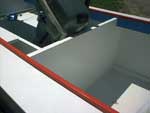| Motor
Well Slot Cover for the Bolger Light Schooner
…or other boats with similar motor wells

click images to enlarge
Phil Bolger’s Light Schooner is a fun boat.
It’s very fast and has plenty of room for both
of your friends. (We both know perfectly well that
the rest of them abandoned you after the last “hull
flipping party”.) It also works very well as
a power launch for fishing, so long as you don’t
mind traveling at displacement speeds.
There are a few issues with the design, though. First,
most builders seem to feel the design should have
incorporated closed bulkheads for flotation. The lack
of flotation is because it was originally designed
very light for racing. Anyone using it for anything
else soon encloses the compartments. The other complaint
is the motor well, which is not quite so easily remedied.
I find only one redeeming quality of this motor well
– the motor is invisible to thieves when the
boat is tarped. But a simpler well would allow me
to easily remove it! I thought it would be great to
have the prop in front of the rudder for helm control
even when not moving. In practice there is too much
gap between them for it to make much difference. The
stowage hatches are not terribly useful wedged next
to the motor, but certainly better than the open compartments
specified. The open compartments leave a nice space
for the fuel tank, but you need the buoyancy. And
you want those gasoline fumes to drain out the bottom,
not collect in a compartment to explode. But when
you deck it over, at least one hatch cover is nearly
useless because of the gas tank tied down on top of
it. (You do tie down your gas tank, don’t you?)
But the biggest trouble is the slot. Bolger doesn’t
specify a cover, but apparently this slot becomes
a geyser when sailing at high speed unless it is sealed
reasonably well. I haven’t tested this, but
I believe it. Several builders have sites about this
boat, but none talk much about how they sealed off
the motor well slot. One gets the impression that
nobody is entirely satisfied with the results. Here’s
how I dealt with it.
The most obvious approach is to use the piece of
wood cut out of the hole to plug it. I built one of
these by attaching it to a piece of ¼”
plywood. I also added a strip of wood in the motor
well to trap one edge of the plug, and a screweye
as a lift handle on the other side. To hold it down
I drilled holes in both the plug and the lip it rests
on. Pretty obvious so far, right? Here’s the
clever part. It is “sewn” down by a 1/8”
line stopper knotted on the top side of the plug,
passing down through the plug, then coming up through
the hole in the lip. This line locks the plug down
and can be cleated inside the motor well.
Here’s the underside with it “sewn”
closed.

Here’s the cover closed, from above.

The arrow is pointing at the screweye, which is very
important. Since fresh latex paint tends to stick
to other latex paint, it took a bit of force to get
the thing open. After uncleating, the standing end
of the lanyard was passed through the eye. Pulling
on it gets the cover loose. After the paint started
getting harder and oilier, this wasn’t necessary
anymore.
It’s a bit of a pain to use because of little
clearance between the motor’s lower unit and
the plug. I have to just about tangle the prop in
my steering lines to get the plug out. Once the cover
is maneuvered around the motor’s lower unit,
it can be hung by the screweye, cleating the line
to retain it while motoring.

And here it is motoring at maybe 4 mph:

This is how much water is in the well when sailing
at about 4 mph. At higher speeds there might be a
little more water sloshing around in there, but it
never turns into a geyser.

But if I had to do it over, I’d go with a simple
Michalak-style motor well for any sailboat. Live and
learn. Then again, Michalak’s Dani Jay has a
motor well rather like this one. No big deal unless
you try to sail it, but he did draw a sailing rig.
(Under duress, though.) So maybe Dani Jay builders
should consider keeping it simple and skipping the
sailing rig.
To be fair, I voluntarily complicated this with remote
steering. I further complicated this by using a Johnson
5.5, which is much bigger than the specified 2 hp
1 cylinder chainsaw-with-a-prop. Where I live, “fisherman
sized” motors are cheap, but a 2hp engine is
an expensive novelty. And I like having all the power
I want at a very quiet ½ throttle, as well
as having full gear shift, which suits my remote steering.
But the sheer size of the old beast caused a problem
or two. Here’s how the motor didn’t fit:

And here’s the notch I cut to fit the bigger
motor.

Suffice it to say that this system should work much
easier with the steering and motor the plans call
for.
Next time we’ll talk about some more radical
modifications to improve (I think…) this motor
well.
Rob Rohde-Szudy
Madison, Wisconsin, USA
robrohdeszudy@yahoo.com
On to
Part 2

Other Articles by Rob Rohde-Szudy:
|